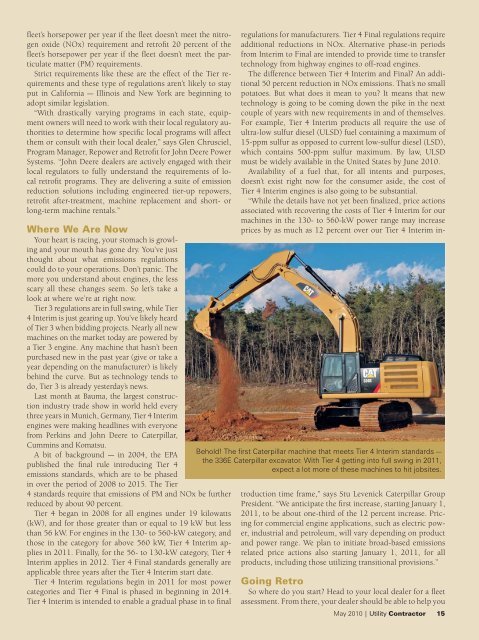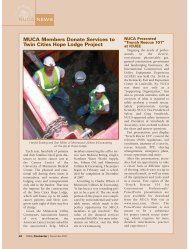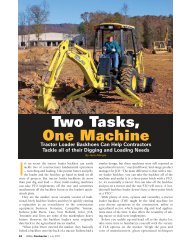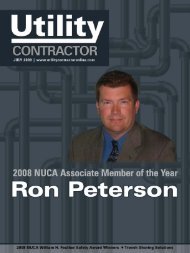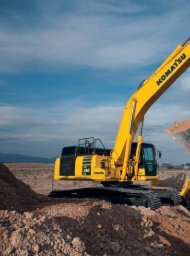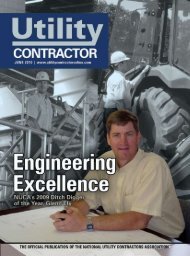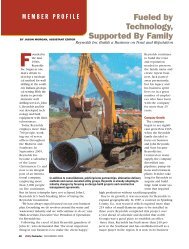View Full May PDF Issue - Utility Contractor Online
View Full May PDF Issue - Utility Contractor Online
View Full May PDF Issue - Utility Contractor Online
You also want an ePaper? Increase the reach of your titles
YUMPU automatically turns print PDFs into web optimized ePapers that Google loves.
fleet’s horsepower per year if the fleet doesn’t meet the nitrogen<br />
oxide (NOx) requirement and retrofit 20 percent of the<br />
fleet’s horsepower per year if the fleet doesn’t meet the particulate<br />
matter (PM) requirements.<br />
Strict requirements like these are the effect of the Tier requirements<br />
and these type of regulations aren’t likely to stay<br />
put in California — Illinois and New York are beginning to<br />
adopt similar legislation.<br />
“With drastically varying programs in each state, equipment<br />
owners will need to work with their local regulatory authorities<br />
to determine how specific local programs will affect<br />
them or consult with their local dealer,” says Glen Chrusciel,<br />
Program Manager, Repower and Retrofit for John Deere Power<br />
Systems. “John Deere dealers are actively engaged with their<br />
local regulators to fully understand the requirements of local<br />
retrofit programs. They are delivering a suite of emission<br />
reduction solutions including engineered tier-up repowers,<br />
retrofit after-treatment, machine replacement and short- or<br />
long-term machine rentals.”<br />
Where We Are Now<br />
Your heart is racing, your stomach is growling<br />
and your mouth has gone dry. You’ve just<br />
thought about what emissions regulations<br />
could do to your operations. Don’t panic. The<br />
more you understand about engines, the less<br />
scary all these changes seem. So let’s take a<br />
look at where we’re at right now.<br />
Tier 3 regulations are in full swing, while Tier<br />
4 Interim is just gearing up. You’ve likely heard<br />
of Tier 3 when bidding projects. Nearly all new<br />
machines on the market today are powered by<br />
a Tier 3 engine. Any machine that hasn’t been<br />
purchased new in the past year (give or take a<br />
year depending on the manufacturer) is likely<br />
behind the curve. But as technology tends to<br />
do, Tier 3 is already yesterday’s news.<br />
Last month at Bauma, the largest construction<br />
industry trade show in world held every<br />
three years in Munich, Germany, Tier 4 Interim<br />
engines were making headlines with everyone<br />
from Perkins and John Deere to Caterpillar,<br />
Cummins and Komatsu.<br />
A bit of background — in 2004, the EPA<br />
published the final rule introducing Tier 4<br />
emissions standards, which are to be phased<br />
in over the period of 2008 to 2015. The Tier<br />
4 standards require that emissions of PM and NOx be further<br />
reduced by about 90 percent.<br />
Tier 4 began in 2008 for all engines under 19 kilowatts<br />
(kW), and for those greater than or equal to 19 kW but less<br />
than 56 kW. For engines in the 130- to 560-kW category, and<br />
those in the category for above 560 kW, Tier 4 Interim applies<br />
in 2011. Finally, for the 56- to 130-kW category, Tier 4<br />
Interim applies in 2012. Tier 4 Final standards generally are<br />
applicable three years after the Tier 4 Interim start date.<br />
Tier 4 Interim regulations begin in 2011 for most power<br />
categories and Tier 4 Final is phased in beginning in 2014.<br />
Tier 4 Interim is intended to enable a gradual phase in to final<br />
Behold! The first Caterpillar machine that meets Tier 4 Interim standards —<br />
the 336E Caterpillar excavator. With Tier 4 getting into full swing in 2011,<br />
expect a lot more of these machines to hit jobsites.<br />
regulations for manufacturers. Tier 4 Final regulations require<br />
additional reductions in NOx. Alternative phase-in periods<br />
from Interim to Final are intended to provide time to transfer<br />
technology from highway engines to off-road engines.<br />
The difference between Tier 4 Interim and Final? An additional<br />
50 percent reduction in NOx emissions. That’s no small<br />
potatoes. But what does it mean to you? It means that new<br />
technology is going to be coming down the pike in the next<br />
couple of years with new requirements in and of themselves.<br />
For example, Tier 4 Interim products all require the use of<br />
ultra-low sulfur diesel (ULSD) fuel containing a maximum of<br />
15-ppm sulfur as opposed to current low-sulfur diesel (LSD),<br />
which contains 500-ppm sulfur maximum. By law, ULSD<br />
must be widely available in the United States by June 2010.<br />
Availability of a fuel that, for all intents and purposes,<br />
doesn’t exist right now for the consumer aside, the cost of<br />
Tier 4 Interim engines is also going to be substantial.<br />
“While the details have not yet been finalized, price actions<br />
associated with recovering the costs of Tier 4 Interim for our<br />
machines in the 130- to 560-kW power range may increase<br />
prices by as much as 12 percent over our Tier 4 Interim introduction<br />
time frame,” says Stu Levenick Caterpillar Group<br />
President. “We anticipate the first increase, starting January 1,<br />
2011, to be about one-third of the 12 percent increase. Pricing<br />
for commercial engine applications, such as electric power,<br />
industrial and petroleum, will vary depending on product<br />
and power range. We plan to initiate broad-based emissions<br />
related price actions also starting January 1, 2011, for all<br />
products, including those utilizing transitional provisions.”<br />
Going Retro<br />
So where do you start? Head to your local dealer for a fleet<br />
assessment. From there, your dealer should be able to help you<br />
<strong>May</strong> 2010 | <strong>Utility</strong> <strong>Contractor</strong> 15


